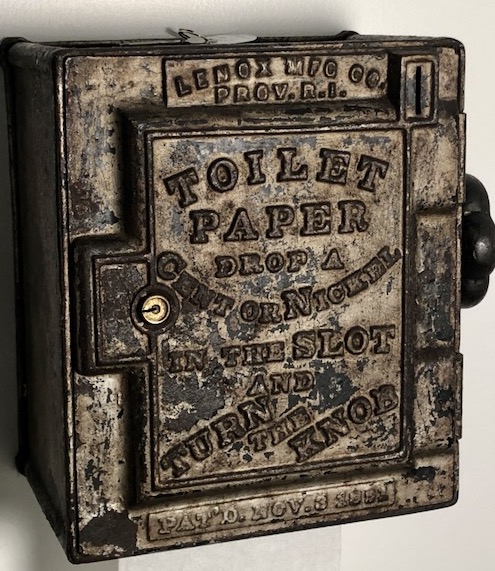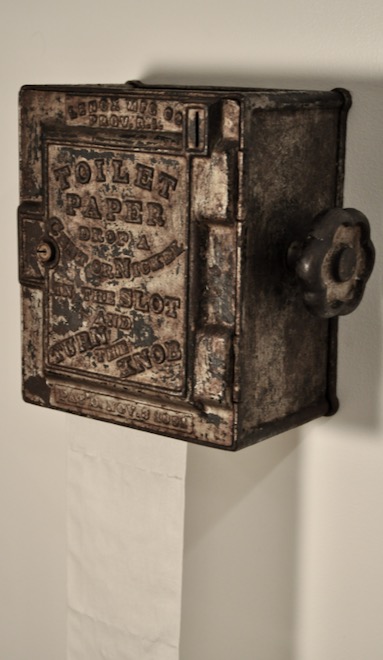___________________________________________________________________________________________
Lenox Toilet Paper Vendor


___________________________________________________________________________________________


Lenox Mfg. Co., Providence, RI, c. 1891, 9 1/4". Where do I start with this one? It's not pretty but man is it cool! It's made of thick cast iron and could be used as a boat anchor. I should have weighed it before wall-mounting it, but didn't think of it until just now as I was typing this sentence. My guess would be about 40 pounds, maybe few more or less, but I'd lay odds against the "less." I also should have photographed it before mounting it when I could have used better lighting, and I did think of that but wanted to show it with the toilet paper hanging down, which you can see if you squint but there's not much contrast against the white wall behind it, which goes straight to the lighting and skills of the photographer (I should fire him but he works for free, so I'm stuck). The machine is darker in person than it is in the photos, but the writing didn't stand out until I lightened things up, and I thought it was important to see that writing rather than show you a darkish-gray shadow. In case you can't make out all the writing on the front, here's what it says:
The way this works is quite clever. You can see the machine's innards here, although the most interesting bits are covered by the paper. It holds one roll, which is held in place by a cast iron spindle whose ends slide into slots on each side of the interior. The slots are angled at about 45 degrees toward the upper front of the machine, allowing you to remove the spindle (and hence the roll) by lifting up and out. Installing a new roll is a little trickier because you're working blind and have to fit the spindle into the slots by feel, but it's not as fumbly as that sounds.
The paper flows over the top of the roll toward the front, then down the front of the roll, and then toward the back of the machine. At the back the paper makes a U-turn and heads toward the machine's front---we'll come back to that U-turn in a minute. After the U-turn it immediately contacts the surface of a drum that's covered with a rough material that grips the paper as it rotates. The drum is rotated by the big knob on the side of the machine, which you can turn after you pay for the privilege. As you turn, the paper is pulled forward by the drum and around the drum and comes out of a slot in the bottom front of the machine. This high-grip drum is one of the two most interesting features of the design.
Okay, back to the U-turn, which is the other one of the design's two most interesting features. The shortest path for the paper would be to come down over the roll and slide directly into the exit slot, but on that path there's nothing to grip the paper and pull it down and guide it into the slot. So instead, the paper first goes to the back of the machine and then turns toward the front, where it hooks up with the drum and gets pulled along as the drum rotates. The key to this path is a cast iron roller that routes the paper around it. It rests on top of the drum, sitting in the angle formed by the drum surface and the back wall. The roller looks like the spindle that holds the roll in place, but is shorter and doesn't attach to anything, hence "roller" instead of another "spindle." By wrapping the paper around this heavy roller, the paper's contact with the drum starts at the back wall of the machine and gives the paper the longest length possible to contact the drum's grippy surface. The roller is resting on the drum, separated from it only by the thickness of the paper, and it rolls in place with the drum as the drum rotates. This all creates a good grip on the paper without creating hot-spots of tension that would tear the paper inside the machine, and instead the tension is distributed evenly over a wide surface area. This is such a simple and effective design that it's ingenious!
The machine above is 100% original. I bought it from a friend, through another friend, at the November 2021 Chicagoland show. The only question I had when it was offered to me was whether it worked, so I had three big burley-men hold it up as I ran a penny through it---it's that heavy!---and it worked like it was 1892. I've never seen another one of these and didn't know the model existed until I saw this one at the show. It's not pretty but it's also not ugly, it's just kind of industrial-looking. From the standpoint of novelty and interesting-ness, though, it's hard to beat.
___________________________________________________________________________________________
___________________________________________________________________________________________
©Small Vintage Vending 2022